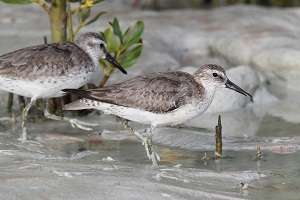More research needed into Roebuck Bay feeding grounds

Scientists at the Royal Netherlands Institute of Sea Research have been sampling Roebuck Bay's benthic marine life, as part of a larger study of migrating shorebirds.
The bay, in the Kimberley, is an important feeding ground for species such as red knots, great knots and bar-tailed godwits, which spend the northern winter there gaining weight and body condition.
The research was triggered by an interest in their foraging ecology.
For 16 years biologists Tanya Compton and Marc Lavaleye have collected mud- and sand-dwelling organisms that the birds feed on, such as bivalves, worms and crabs.
Dr Lavaleye gave the example of an organism that had been abundant in the mud of Crab Creek. "You had a bivalve of about two centimetres, it was very abundant, it's called the Siliqua," he says. "It was very good food for birds – especially the knots. They swallow them whole and they crack them in their stomach."
She says that on their latest trip they only found four Siliqua specimens, while at the same time finding peanut worms (Sipuncula) in almost every sample.
Dr Compton says it is too early to interpret these trends as either normal fluctuation or permanent ecological change.
"We can see trends but to understand what those trends mean you need to keep monitoring, you need to keep going there," she says. "Australian funds were limited for benthic work in Roebuck Bay this year, limiting the ability for a more expanded Australian collaboration."
She says a post-graduate student from an Australian university conducting extensive benthos sampling every year would contribute a better understanding of how shorebirds' food sources vary in time and space.
Dr Lavaleye says they made the first big survey of the Roebuck Bay tidal flats in 1997 after preliminary studies by students. Making a grid of a large area, they sampled mud at stations 200 metres apart, examining each with one-millimetre sieves. They repeated the survey in 2002 and 2006, and surveyed a smaller area this year. "And at the same time we initiated a program at two sites… to sample them monthly to see what would change over the time – and that program is still ongoing," Dr Lavaleye says.
Provided by Science Network WA

















